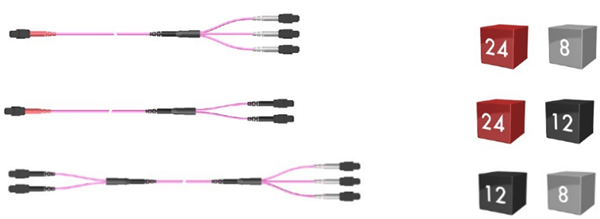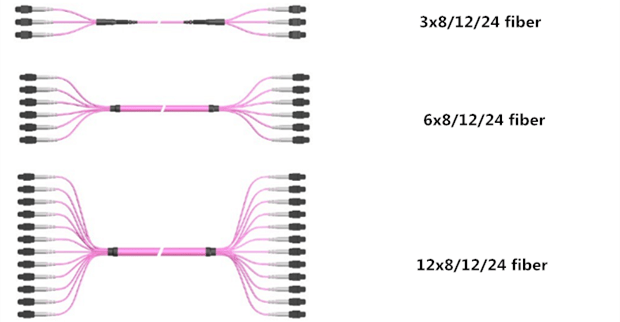MPO Harness Cables 3 Types
MPO Harness Cables Have 3 Types used in Today’s Data Center around the global.Let’s see 3 different type and application.

1- MPO-LC harness cables
As we know, harness cables are generally used to connect high-density switches with LC serial transceivers installed. The transition harness connects to the pre-installed MPO backbone trunk cable and then furcates to LC connectors entering the switch. This kind of MPO-LC harness cables are usually supplied in short lengths because they are normally only used for “in-rack” connections. Transition harnesses are available for Base-8, 12 and 24 backbones and the LC tails are numbered for clear port identification and traceability.

in This picture you can see how you can use MPO-LC harness cables

2-MPO/MTP Conversion Harness Cables

Another harness cable type is conversion harness cables, which allow users to convert their existing MPO backbone cables to an MPO type which matches their active equipment. Conversion harnesses are a low-loss alternative to conversion modules because they eliminate one mated MPO pair across the link. Many of today’s legacy infrastructures are built using a Base-12 MPO backbone design, however experience shows us that this connector is rarely used on higher data rate switches or servers. Currently Base-8 is the preferred connector for 40G (SR4) transceivers and Base-24 is the preferred connector for 100G transceivers (SR10).
3-MPO/MTP Trunk Harness Cables

The final type of harness cable is MPO trunk harness cables. MPO trunk harness cables are high density multi-stranded cables which form the backbone of the data center. This kind of trunk harness cables are available in different fiber-counts up to 144 fibers, which reduce the installation time by consolidating multiple sub-units into a single cable. This approach significantly reduces the overall diameter of the cable and provides much better space utilization of cable routing channels. Just as two types harness cables mentioned, the MPO trunk harness cables are also available with 8, 12 and 24 fiber sub-units so that users can deploy Base-8, Base-12 or Base-24 infrastructures to suit their MPO connectivity requirements.
